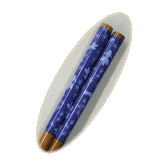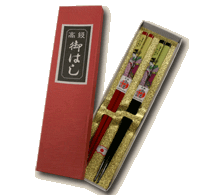 Long term foreign residents agree that one of the most infuriating things in Japan is the incredulous gushing of: "Oh, you can use chopsticks!!" Of course, most of us knew how to use chopsticks long before setting foot in Japan. Along with becoming a Pachinko pinball virtuoso or speaking fluent Japanese, however, using chopsticks is like breaking a commandment - one of the Things That Foreigners Do Not Do! Chopsticks have probably been used in Japan for 2,000 years - ever since the Chinese and/or Koreans first set foot there. Sized mid-way between the larger Chinese version and the thin, tapering (and now usually metal) Korean variety, Japanese chopsticks come in a variety of forms, and are called hashi. Long, thick wooden ones are used for cooking; long metal ones are used like tongs for fishing things from the embers. Usually made of wood, the ordinary eating hashi come in different shapes and sizes too. They can be attractively decorated, notably with lacquer. Many households keep hashi in individual boxes for each family member. The most beautiful are reserved for special occasions like New Year celebrations.
Long term foreign residents agree that one of the most infuriating things in Japan is the incredulous gushing of: "Oh, you can use chopsticks!!" Of course, most of us knew how to use chopsticks long before setting foot in Japan. Along with becoming a Pachinko pinball virtuoso or speaking fluent Japanese, however, using chopsticks is like breaking a commandment - one of the Things That Foreigners Do Not Do! Chopsticks have probably been used in Japan for 2,000 years - ever since the Chinese and/or Koreans first set foot there. Sized mid-way between the larger Chinese version and the thin, tapering (and now usually metal) Korean variety, Japanese chopsticks come in a variety of forms, and are called hashi. Long, thick wooden ones are used for cooking; long metal ones are used like tongs for fishing things from the embers. Usually made of wood, the ordinary eating hashi come in different shapes and sizes too. They can be attractively decorated, notably with lacquer. Many households keep hashi in individual boxes for each family member. The most beautiful are reserved for special occasions like New Year celebrations.Called waribashi (breaking chopsticks) and contained in paper wrappers, those used in restaurants consist of a strip of wood with a longitudinal centre groove sufficiently deep for it to be broken into two halves. The best are sometimes joined only at the top and the sticks have been rounded, tapered and smoothed. The use of waribashi is becoming increasingly controversial: the timber used is imported mainly from Southeast Asian countries in which reforestation and conservation are low priorities, though some also come from the USA, where a Minnesota firm makes seven million waribashi a day. According to an estimate during the late 1980s, the Japanese use and throw away 11,000 million waribashi every day. Although they would make a viable alternative, plastic chopsticks are not popular, except for small children. Being difficult to break and unchewable, they make good learning tools. Politeness is paramount to the Japanese, so it comes as no surprise that there is some elaborate etiquette regarding the use of chopsticks.
 Many types of food are served in individual portions but, as in most of Asia, many dishes in Japan are traditionally placed on the table for communal use. It is important to know how each morsel is to be conveyed from dish to individual plate or rice-bowl, and into the mouth. Most of the misdemeanors involving hashi have names. Namidabashi (crying chopsticks) means allowing food or sauces to drip off your chopsticks onto the table; tatakibashi (hitting chopsticks) is the crime committed by the would-be after-dinner speaker tapping his chopsticks against the tableware to draw attention. Additionally, one must never wave chopsticks over the dishes and dither before homing in on one, spear pieces of food with them, or close one's mouth around them or suck them - at least not if anyone's looking. Similarly, never stick chopsticks upright in a bowl of rice (this is said to be unlucky as it evokes images of incense sticks standing in a joss bowl at a funeral) and chopsticks should always be placed on the hashi-oki (chopsticks rest) when finished. Japanese friends concurred about such classic no-nos in this particular social minefield, but there tend to be regional variants too.
Many types of food are served in individual portions but, as in most of Asia, many dishes in Japan are traditionally placed on the table for communal use. It is important to know how each morsel is to be conveyed from dish to individual plate or rice-bowl, and into the mouth. Most of the misdemeanors involving hashi have names. Namidabashi (crying chopsticks) means allowing food or sauces to drip off your chopsticks onto the table; tatakibashi (hitting chopsticks) is the crime committed by the would-be after-dinner speaker tapping his chopsticks against the tableware to draw attention. Additionally, one must never wave chopsticks over the dishes and dither before homing in on one, spear pieces of food with them, or close one's mouth around them or suck them - at least not if anyone's looking. Similarly, never stick chopsticks upright in a bowl of rice (this is said to be unlucky as it evokes images of incense sticks standing in a joss bowl at a funeral) and chopsticks should always be placed on the hashi-oki (chopsticks rest) when finished. Japanese friends concurred about such classic no-nos in this particular social minefield, but there tend to be regional variants too.



No comments:
Post a Comment
Thank you for commenting on -Chopsticks-, a personal blog that touches on pop culture. Kindly note that I will comment back on your blog (on your latest blog post) as soon as I possibly can, unless I'm not online.
Rules:
1. Kindly avoid promotional/non-sense/unrelated comments as this can be reason for deletion of your comments.
2. Avoid commenting with "nice post"/"thanks for sharing", or the likes. Kindly just read the post and comment something about it.
3. Replying with some facts/rumors or other info related to the post is well appreciated too.
Your comments always make my day(s) feel special and appreciated and each comment will be followed up as well. Thank you and have a wonderful day ahead~